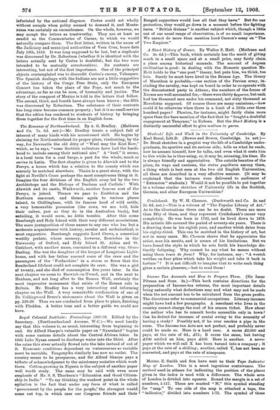The Romance of Northumberland. By A. G. Bradley. (Methuen and
Co. 7s. 6d. net.)—Mr. Bradley treats a subject full of interest of many kinds with his accustomed skill. He begins by claiming for Northumberland its proper place, vindicating, by the way, for Newcastle the old ditty of " Weel may the Keel Row," which, as he says, "some Scottish collectors have had the hardi- hood to include among their national airs." A "keel." it seems, is a local term for a coal barge, a part for the whole, much as earina in Latin. The first chanter is given to Alnwick and to the Pereys, a house which has a relation to the county which can scarcely be matched elsewhere. Theirs is a great story, with the fight at Neville's Cross perhaps the most conspicuous thing in it. Imagine the four divisions of the English army led by the two Archbishops and the Bishops of Durham and Carlisle ! With Alnwick and its castle, Warkworth, another famous seat of the Percys, is joined. Thence we pass to Embleton and the Northern sea-coast, and thence again to various places inland, to Chillingham, with its famous herd of wild cattle, a very honourable possession (the cows, we are told, hide their calves, just as they do in the Australian bush), but entailing, it would seem, no little trouble. After this come Bamburgh and Holy Island with their very different associations. The mere juxtaposition of these names to any one who has but a Moderate acquaintance with history, secular and ecclesiastical, is most suggestive. Bamburgh suggests Lord Crewe, a somewhat worldly prelate, whose memory, however, flourishes in the University of Oxford, and Holy Island St. Aidan and St. Cuthbert, with another name, canonised in a different way, Grace Darling. She was the daughter of the keeper of Longstone Light- house, and with her father rescued some of the crew and the passengers of the Forfarshire' in a storm so fierce that the Sunderland lifeboat could not complete its crew. She was a girl of twenty, and she died of consumption five years later. In the next chapter we come to Berwick-on-Tweed, and in the next to Hexham, and not long after to the Roman Wall, certainly the most impressive monument that exists of the Roman rule in Britain. Mr. Bradley has a very interesting and informing chapter on the Wall. A very remarkable confirmation of one of Dr. Collingwood Bruce's statements about the Wall is given on pp. 228-29. Thus we are conducted from place to place, finishing with Flodden. A better tour and a better guide we could not have.










































 Previous page
Previous page